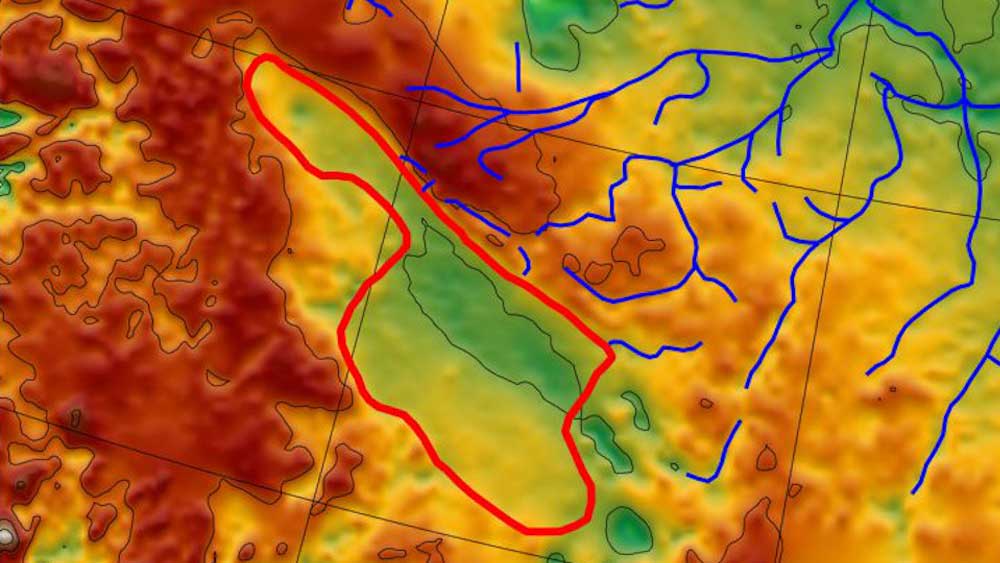Scientists from the Lamont-Doherty Observatory discovered an enormous ancient lakebed beneath the ice on Greenland.1 Although scientists have found other lakes beneath the ice in Greenland and Antarctica, this was the first dry lakebed found below the ice.2 The new discovery came as a surprise to secular scientists, but it fits perfectly into the Flood narrative.
Using airborne radar, gravity, and magnetic data from NASA’s Operation IceBridge, the team identified a pre-glacial lakebed that is 2,740 square miles in area, about the same size as Delaware and Rhode Island combined. Though it’s dry now, at one time it contained water as deep as 820 feet.2
Radar data allowed the team to map the detailed topography of the lakebed below the 1.1 miles of ice, and the gravity and magnetic data permitted an estimate of the thickness of lakebed sediments. Sediments are assumed to be lower density (less gravity) and less magnetic than the crystalline bedrock.
Publishing their results in Earth and Planetary Science Letters, Guy Paxman and his co-authors concluded that the pre-ice lake sediments are about 0.75 miles thick.2 They also found well-defined erosional lake terraces on the edge of the lake that indicated its past water level.1
Of course, the three-quarter mile of sediment is assumed to have taken hundreds of thousands or even millions of years to accumulate.2 But these ages are based on uniformitarian assumptions. Under the right conditions, these sediments could have easily built up in just a few hundred years or less.
Looking at the evidence from both a scientific and biblical perspective rather than a uniformitarian one, it seems likely that this lake formed at the end of the global Flood, after the water had fully drained off the continents and before the onset of the Ice Age. This places the lake sediments on top of the Tejas Megasequence, which is interpreted as the layer formed during the receding phase of the Flood.3
After the Flood ended, there may have been about a hundred years that passed prior to the onset of ice sheet development across Greenland.3 This would provide ample time for lake water to carve terraces and for the thick sediment to accumulate in the lakebed, especially with the heavy rains expected at the end of the Flood due to the warmer oceans and higher evaporation. Other glacial lakes have carved a series of terraces as they rose and fell, including Lake Bonneville, the precursor to the Great Salt Lake.3
The team from Lamont-Doherty also found that at least 18 former streams drained into the lake, which could have provided the sediments needed to fill the lakebed quickly.
High post-Flood rainfall from warmer oceans would foster the conditions necessary to form the lake rapidly after the Flood. The heavy rainfall provided water for the surrounding streams to erode the landscape and fill the lakebed with thousands of feet of sediment. Eventually, the increase in volcanic activity toward the end of the Flood and in the early post-Flood period cooled the climate until this rain turned to snow.3 Thick snow built up across Greenland and over time became ice, creating the massive ice sheet that covers this ancient lakebed today.
All of these events happened just thousands of years ago, not over millions of years. A lot of time is not required, just the right conditions. And the global Flood provided the perfect conditions. The Ice Age came and went after the Flood, providing temporary land bridges for post-Flood migration of animals and humans alike.3 God accomplished His plan and purpose for the Ice Age,3 and He left a few reminders in the ice sheets across Greenland and Antarctica.
Stage image: Ancient basin beneath a mile of ice.
Stage image credit: Paxman et al., EPSL. Copyright © 2020. Adapted for use in accordance with federal copyright (fair use doctrine) law. Usage by ICR does not imply endorsement of copyright holders.
References
1. Paxman, G. J. G. et al. 2020. A fault-bounded palaeo-lake basin preserved beneath the Greenland Ice Sheet. Earth and Planetary Science Letters. 116647: ISSN 0012-821X.
2. Dvorsky, G. 2020. Scientists have discovered an ancient lakebed beneath Greenland’s ice. Gizmodo. Posted at gizmodo.com November 10, 2020, accessed November 17, 2020.
3. Clarey, T. 2020. Carved in Stone: Geological Evidence of the Worldwide Flood. Dallas, TX: Institute for Creation Research, 354-377.
*Dr. Clarey is Research Associate at the Institute for Creation Research and earned his doctorate in geology from Western Michigan University.

Greenland Lakebed Fits Flood Narrative
The Latest
Puzzling Fossils at an Unlikely Time
Wherever and whenever life is found, it is incredibly complex. This certainly applies to cyanobacterial photosynthetic life that supposedly were some...
CREATION PODCAST
A Theory Designed to Be...Anti-Design | The Creation Podcast:...
Science is objective. At least, that’s what we’re told. But there are inherent issues with this statement that can...
Seeing the Case for Creation in Fruit Flies
Our brain is designed to smoothly and constantly process what we see via the incredibly sensitive photoreceptors (cones and rods) of our eyes.1...
Amazing Defense Systems
Bacteria (prokaryotes) are ubiquitous. A fraction cause disease in people, animals, and plants, but the majority are the foundation for the global food...
Octopus and Fish Plan a Complex Coordinated Hunt
The octopus—an invertebrate—never fails to surprise researchers with its incredible abilities.1,2
The octopus was designed...
A ''40 million year old'' 100% European Gnat
Finding well-preserved creatures in amber1 is a landfall for creation scientists, much like the numerous discoveries of soft dinosaur tissue...
CREATION PODCAST
The Undeniable Power of Narrative | The Creation Podcast: Episode...
Science is objective. At least, that’s what we’re told. But there are inherent issues with this statement that can cause...
Paintbrush of the Creator
Who doesn’t enjoy the amazing color patterns of butterflies?1,2 Such beautiful designs and construction do not reflect blind naturalistic...
November 2024 ICR Wallpaper
"Rejoice always, pray without ceasing, in everything give thanks; for this is the will of God in Christ Jesus for you." (1 Thessalonians 5:16-18 NKJV)
ICR...
















